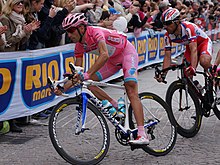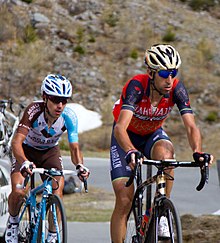Vincenzo Nibali
Nibali is an all-rounder, and is considered one of the strongest stage race riders of his era, having won Tirreno–Adriatico (2012 and 2013), the Giro del Trentino (2008 and 2013) and the 2016 Tour of Oman.
[13] He also finished in second position overall of the 2.1 rated Settimana Internazionale di Coppi e Bartali, taking the win on the first stage.
He was a last-minute addition to Liquigas' Giro d'Italia squad following Franco Pellizotti's last minute withdrawal over Blood Passport irregularities.
On stage six, Liquigas orchestrated an escape on the descent into Córdoba, but a miscommunication saw Nibali finishing fourth, failing to take any bonus seconds.
However, Nibali conceded over two minutes to Wiggins in the time trial on stage nine, where he placed eighth, and slipped to fourth on the GC, behind Team Sky's Froome.
On stage ten, Nibali attacked on the descent of the Col du Grand Colombier and linked up with teammate Peter Sagan, but the pair were caught by the Team Sky led peloton.
In the latter race, he took the leader's jersey off Froome's shoulders in stage 6, where he escaped with Peter Sagan and Joaquim Rodríguez on a short climb with a gradient of 30%.
Nibali powered away on the last Hors Category climb, distancing rivals Mauro Santambrogio and Wiggins, who suffered a mechanical issue, and winning the stage in solo fashion.
Nibali took the leader's pink jersey (Italian: maglia rosa) on stage eight after finishing fourth in the time trial won by Alex Dowsett, conceding only 11 seconds to Wiggins.
Nibali won stage 18, a mountain time trial, by 58 seconds from Samuel Sánchez, to extend his lead over Evans and Urán to over four minutes.
[22] At the Vuelta Nibali was vexed as to whether he should chase the red jersey to record his second grand tour in 2013 or reserve his energy for the World Championships to be held just weeks later in his adopted Tuscany.
On 28 June Nibali became the 2014 Italian Champion with his first win of the year at the national road race championships, based on the route of the Trofeo Melinda.
He first secured the leader's yellow jersey on 6 July by winning the 201 km (125 mi) second stage of the Tour, between York and Sheffield, after breaking away right before the finish.
But he regained it in the tenth stage from Mulhouse to La Planche des Belles Filles after one of his biggest general classification competitors Alberto Contador crashed and abandoned the race, and after catching Joaquim Rodríguez and Michał Kwiatkowski up the final climb to Planche des Belles Filles.
[37][38] It is not known whether Nibali was aware of the problem, since there was no communication from Radio Tour about the incident (as later stated by Astana manager Alexandre Vinokourov).
[41] This would be the 10th consecutive grand tour Nibali entered where he finished in the top 10, an achievement unmatched since Miguel Induráin did so in eleven in a row two decades earlier.
[47][48][49] In October he won his first Monument, Il Lombardia, attacking on the descent of the Civiglio, the penultimate climb, and arriving solo ahead of Daniel Moreno and Thibaut Pinot.
He returned to racing in April at the Giro del Trentino, where he demonstrated a bad condition and finished far from the winner Mikel Landa.
The last race before the Giro was Liège–Bastogne–Liège, the most important of the Ardennes classics, concluded more than two minutes behind the winner after being distanced on the Côte de Saint Nicolas.
However, Steven Kruijswijk (LottoNL–Jumbo) attacked close to the summit, with Esteban Chaves (Orica–GreenEDGE), and the pair dropped Nibali, who lost more than half a minute after the stage.
Stage 19 was the first to head into the high mountains, featuring the Cima Coppi, the Colle Dell'Agnello, and a subsequent descent and climb to a summit finish at Risoul in France.
In tears after the finish, the Shark dedicated the win to Rosario Costa, a young cyclist from Nibali's junior cycling team, who had been killed two weeks before.
Nibali bridged across to the leading 6 man group on the penultimate descent of the Vista Chinesa circuit with teammate Fabio Aru, and on the final climb of the race he broke clear with Rafał Majka and Sergio Henao.
[56] After two podiums at Giro d'Italia and Vuelta a España, in October he won his second Il Lombardia, by attacking again Thibaut Pinot on the descent of the Civiglio and arriving solo in Como.
[57] In March 2018, Nibali won Milan-San Remo, his third cycling monument, becoming the first Italian winner of La Classicissima since Filippo Pozzato in 2006.
[58] Nibali had attacked on the Poggio di San Remo, and managed to hold off the sprinters in the closing kilometers to seal victory.
[59] Two weeks later, he finished 24th in his maiden Tour of Flanders, which included an attack on the Kruisberg that sparked the winning move of Niki Terpstra.
[60] Nibali withdrew from the 2018 Tour de France after stage 12, having suffered a crash on the ascent of the Alpe d'Huez after spectator interference.
With 12 km (7.5 mi) remaining, Nibali attacked and soloed to victory, ten seconds ahead of chasers Mikel Landa and Alejandro Valverde.
[67] After completing the fifth stage of May's Giro d'Italia, which finished in his native Messina, Nibali announced his impending retirement at the end of the season.










